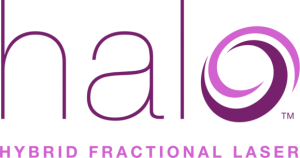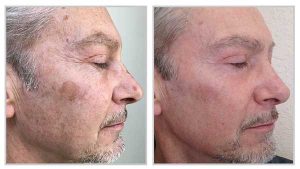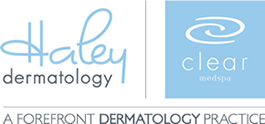Haley Dermatology and Clear Medspa is proud to offer Halo, the first ever hybrid fractional laser to improve patient’s skin appearance, addressing common concerns, such as skin tone, laxity, texture, and more.
How Does Halo Work?
Halo is the first hybrid fractional laser, meaning it delivers non-ablative and ablative wavelengths at the same time.
Ablative lasers have been considered one of the most effective laser treatments to improve common signs of aging, by removing damaged outer layers of skin. Unfortunately, ablative lasers typically require a lengthy downtime of one to two weeks. Non-ablative laser treatments are less-invasive than ablative, carrying minimal downtime. This treatment involves heating up the epidermis of the skin, and generally several laser sessions are required.
The combination approach of the Halo Hybrid Fractional Laser incorporates the best of both worlds. It focuses energy deep to the skin’s collagen layer, while leaving the surface of your skin unharmed for effective results and a shorter recovery time.
What to Expect with the Halo Treatment
Depending on your cosmetic needs, your in-office appointment will last anywhere between two to three hours. First, a numbing cream will be applied to make sure you are comfortable during and after the laser resurfacing. The Halo treatment itself should not last longer than 45 minutes. After treatment, a cold air fan and water mist will help cool down and dissipate heat from your skin before you can return home.
After treatment, you may experience extremely warm skin on the treatment area for up to 24 hours post-op. We recommend cold compresses to calm your skin and help reduce any swelling and redness that occurs. Around the second or third day after Halo, you will notice tiny dark spots and a darker complexion, which is part of the skin’s natural healing process where new, undamaged skin is regenerated. Your skin will begin to flake and peel, which may last up to one week.
Halo Results
After your skin is finished healing, Halo creates beautiful results, with smoother, vibrant skin! The Halo treatment is customizable to precisely target skin damage, improve the appearance of skin’s tone, texture, and wrinkles, reduce pore size, and ultimately make your inner glow shine through.
HALO laser skin resurfacing technology provides patients with significant results and minimal downtime.
Laser skin resurfacing for changes associated with sun damage and aging has grown significantly in popularity. The aesthetic market has experienced a surge in this segment due to innovative technologies and their successful outcomes.
Lasers deliver energy to the treatment area at specific wavelengths and can target pigment, red areas, or water contained in tissues. The laser energy produces heat within the targeted tissue which leads to the improvement in appearance. With earlier laser devices it was necessary for patients to attend multiple sessions and the recovery time was extensive.

Recently, HALO laser skin resurfacing treatments have become the preferred technology of many physicians for the treatment of a variety of dermatological problems which include: sun damage/ dyschromia, signs of aging, enlarged pores, discoloration, fine lines on the face, poor texture, scars, and uneven skin tone. This cutting edge technology gives physicians the ability to customize treatment for each individual patient based on the desired effects. In addition, the method is safe, easy, and has less discomfort compared to older technology. As a result, patients generally require fewer prescribed treatments, and their recovery time is minimalized.
If you are considering HALO or a traditional laser skin resurfacing here is some information that will be helpful in making your decision.
Potential Side Effects from Laser Resurfacing Procedures
In some cases patients will experience temporary side effects from a laser resurfacing procedure. Potential complications commonly experienced are acute skin reactions like itchiness and redness. These occur as a result from the heat of the laser on the skin. It can take a few days for these reactions to subside.
While burns, blisters, and infections may occur with any laser resurfacing procedure, these are relatively rare with HALO, especially when utilized by an experienced physician familiar with the appropriate settings.
Most skin types can be treated with HALO. Gentler settings are used for darker skin types to minimize the risk of post inflammatory hyperpigmentation (PIH). Therefore, darker skin types often will require a higher total number of treatments for optimal results. Hypopigmentation (lighter areas) was relatively common with the earliest CO2 laser resurfacing devices in the 1990s, but this is exceedingly rare with fractionated resurfacing lasers like HALO.
Misunderstandings About Aesthetic Laser Resurfacing
The stronger the laser the better.
- Some people believe the myth that the redder their face is, the better the treatment. This is incorrect. Redness occurs from over- stimulation by the laser energy. Your dermatologist physician specializes in the treatment of skin and will know your dermatological tolerance. While they preform your treatment, the physician is paying close attention to how your skin is reacting and will determine the depth and energy level of treatment for each session. Treatments are usually spaced 4-6 weeks apart.
Why do I need more than one treatment?
- Deeper pigment is more stubborn and will require more time to treat while superficial pigment can be removed by the laser more easily. Your physician can educate you on your pigmentation and help you understand what to expect for a prescribed treatment.
Should I avoid the sun while I am undergoing resurfacing treatment?
- Although daily sun protection is advised in general, sun protection is critical one month before and during the days of recovery after treatment. Strict daily application of zinc containing sunscreen, sun avoidance, or physical barrier protection during these periods will help minimize the risk of postinflammatory hyperpigmentation (PIH).
Lasers will cause my skin to thin.
- This is incorrect. Today’s lasers do not have the ability to cut or burn layers of skin. In many cases, today’s technologies actually generate skin growth through the production of new collagen and will cause the skin to feel more firm!

